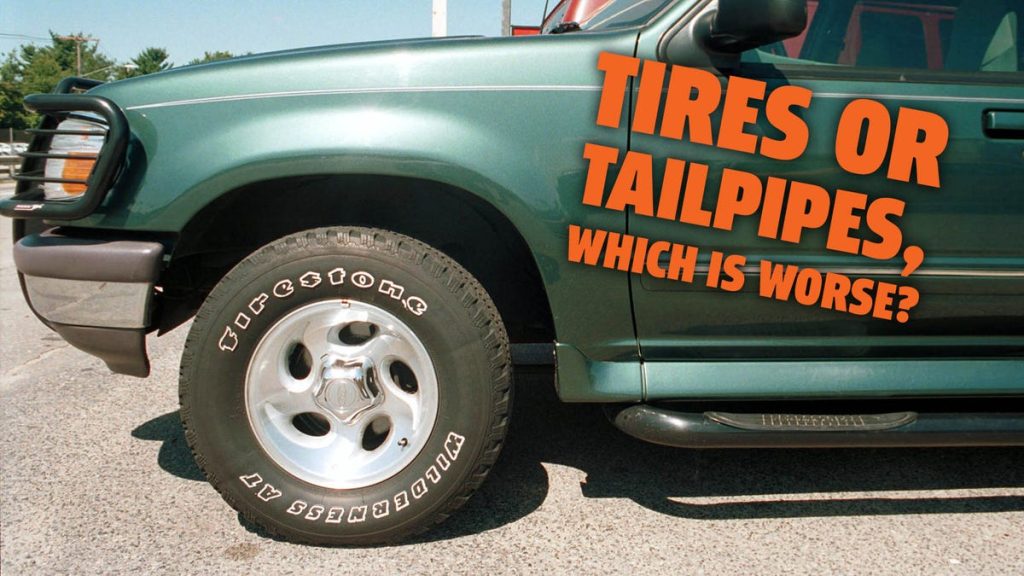Emissions from Tire Wear Are a Whole Lot Worse Than We Thought

Tires, it’s definitely tires. Photo: Darren McCollester/Newsmakers (Getty Images)
Update: pretty much every aspect of driving is bad for the environment. That’s not really news, but if you want another area of your car to worry about over its impact on the planet, then I’ve got good news for you. It turns out that tires are even worse for the environment than we thought, so much so that the particulate emissions from tire wear could be as much as 2,000 times greater than from your tailpipe.
That’s according to a new study in Europe, which compared the particulates produced by tire wear in a variety of situations with the emissions at your tailpipe.
The study, which was undertaken at the National Physical Laboratory in the UK by independent emissions testing company Emissions Analytics, found that under normal conditions particulate matter released by tire wear is 1,850 times more than the amount of particulates that come from burning the gas in your engine.
To come up with this insanely high number, researchers compared real-world tailpipe emissions with the amount of microplastics released through tire wear. The study compared regular driving with aggressive driving, and new tires with used tires.
Lawmakers have clamped down on particulate emissions at the tailpipe. Photo: Matt Cardy (Getty Images)
And What Did They Find?
That headline figure of 2,000 times more particulates comes when you compare the real world tailpipe emissions with the “normal” driver that runs used tires. In each case, the emissions were 0.02 mg/km and 36.5 mg/km respectively.
When compared with the aggressive driver, the results are even more alarming as the particulate matter released through tire wear is 288,000 times as much as tailpipe particulate emissions.
Of course, we’ve known for a while that particulate emissions from tires are worse than those coming out the exhaust. In fact, a study from this very same company in 2020 found as much.
The big difference between the two studies, however, comes when you look at the statistics they opted to compare. In 2020, that was the legal limit for particulate emissions from tailpipes compared with those from aggressive driving. Back then, Emissions Analytics said tires were 1,000 times worse than tailpipes.
But what are those legal allowances for particulate emissions from tailpipes? Well here in the U.S., it’s 2 mg/km while the EU will permit cars to run up to 4.5 mg/km.
For those of you still stuck in 1799, that’s 0.0001 of an ounce for every mile covered here in the US and 0.0002 in Europe. That’s the only imperial measure I’m including here — this is science we’re talking about after all.
News Flash: Driving is bad for the planet. Photo: Bruno Vincent (Getty Images)
So Have Particulate Emissions Doubled?
Well, no.
The previous study discussed the differences between the legal tailpipe emissions limit in Europe with the particulates produced by a “popular family hatchback running on brand new, correctly inflated tires.” At the time, it said the particulates from tire wear were 5,800 mg per kilometer, compared with the 4.5 mg/km permitted under the EU’s exhaust regulations.
However, in the new study, this figure is closer to the amount of particulate emissions the company claims come through aggressive driving, which was 5,760 mg/km. The amount of particulate matter released during regular driving with new tires and used tires is considerably lower, 73 mg per km and 36.5 mg per km respectively.
Additionally, where the first study compared the emissions from a “family hatchback” with the permitted emissions for its class, the latest study took a different tact again.
This time, the aggressive driving figure cited came by analyzing the particulate emissions from a “Volkswagen Golf driven at legal road speeds on a track.” The test also allowed for “fast cornering,” and used the maximum permitted payload in the car, which if you’re interested is 1,045 lbs.
In contrast, the normal driving results were calculated by averaging the particles released by 14 different tire brands that were tested on a Mercedes C-Class that was driven on a normal road “with just the driver and no payload in the vehicle.”
Researchers tested tire wear on a VW Golf. Photo: VW
And what about those tailpipe emission figures? Well, they didn’t come from either a Golf or a C Class. Instead, Emissions Analytics measured the output across “four gasoline mid-sized sports utility vehicles from 2019 and 2020 model years,” which were driven on motorway and urban settings.
This means tire wear on a small hatchback was compared with that of a midsize sedan, which was compared with the tailpipe emissions from an SUV. That seems a bit like comparing apples and oranges.
So we put this to Emissions Analytics to find out why it was the case, and what this means for the comparison of these results.
In an email, founder and CEO Nick Molden explained:
“The four gasoline SUVs were selected as they collectively have a significant market share – both in the US and Europe – so are a good representation of the latest tailpipe emissions. The values are so low due to the high effectiveness of the exhaust particulate filters.
“The C-Class was used for all the tire wear testing, which just happens to be the vehicle we selected a while ago for this work. The exhaust filtration on this vehicle would have been at least, if not more, effective that on the gasoline vehicles, as those filters are more effective than GPFs (gasoline particulate filters).
“Therefore, if anything, we are under-reporting the ratio of tyres-to-tailpipe. The Golf was only used for the testing of the weight addition, and this same vehicle was used for both the without- and with-payload tests, so it is a fair comparison.”
They also looked at how quickly a C Class will chew through its tires. Photo: Mercedes
But How Much Worse Would Emissions Be on the Same Car?
If you do want to compare how the particulates produced by tire wear in a C Class compare to those from its tailpipe, you can do that yourself thanks to strict vehicle advertising laws in the EU that require automakers to publish all their emissions data.
So we looked into that, and the C Class particulate emissions are as low as 0.16 mg/km for the C350e. That means particulate emissions from tire wear are 228 times worse than tailpipe emissions when driving with used tires.
So, what have we learned? Well, the study clearly shows that tightening of regulation around tailpipe emissions is working. The particulates produced by the cars in this report come in far lower than the permitted maximums, which is a great thing.
But the lack of legislation surrounding particulate emissions from tire wear means its percentage of the particulate emissions from driving are on the rise. And as cars get heavier to pack in more hybrid tech and battery power, that variance is only going to get greater.
Clearly, lawmakers must soon turn their attention to the tire wear issues, so that we can all stop having weekly panic attacks about the fate of our planet. No, just me?





